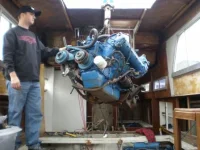Dan - are you going to be doing the rebuild work yourself or having a mechanic do it? In or out of the boat? Obviously it would be far better to do it out of the boat so a machine shop can set up the blocks as they should be.
If the engs are being removed, I'd suggest they go to the machine shop and the following be done (not in order of machining) to ensure long life and maximum efficiency.
1. Cylinders bored/honed to the LEAST oversize possible using Torque plates (also called "hone plates"). If they say torque plates aren't necessary or "we don't use those," thank them and find another shop. I have seen more than 50(!) HP gains by doing this and adjusting piston ring gaps to optimum.
2. Have the rotating parts balanced. Although folks might say this is not a "high performance engine" the fact is that a marine engine runs at consistently higher RPM than a car engine. Balancing is not very expensive and smoother spinning is better.
3. I'd personally recommend you use Sealed Power (Federal Mogul) rings and tell the machine shop - they will know what bore finish is necessary based on the ring selection.
4. Align hone (bore) the block - this ensures the crankshaft rides perfectly square in the main bearing bores. I have seen big blocks gain 30+ HP just by align boring.
There are a lot of other operations that will give you free power - free in the sense that the engine will produce more power using less fuel, not free in the sense that they won't charge you to do the work!

But the most critical are ensuring the bores are round at operating temp which torque plates helps with and the align honing. You could have the block decked as well and precision head work (cc-ing) done but the improvement is not so obvious and now we are heading into "blueprinting" - a good thing but fairly expensive. I have seen a 426 Hemi develop over 100 more HP just by blueprinting - no "Performance" parts added.
As noted above, another item that can pay big dividends is for the shop (or you/mechanic) to hand file (there is a tool for this) the rings to the proper end gap as opposed to just using whatever the rings deliver when installed. As an example, a typical spec for end gap on the compression ring for an engine with a 4" bore might read (in inches): .016-.023. As you can easily see, a production set of rings might give you either of those numbers and/or a mix of anything between them. A piston with a comp ring gap of .016 is going to produce more power and less blowby than a piston with a .025 ring gap. By ensuring they are all the same (and toward the low side of the spec) you again gain efficiency AND reduced engine vibration. There are standard specs for the first and second ring gaps - usually .004 per inch of bore for the first ring and .045 for the second.
If you are going to do this (or have it done) IN the boat, you cannot produce anywhere close to that level of work but you can do a reasonable job that will last a long time if you/mechanic are extremely careful and work slowly using the specs/procedures in the SHOP MANUAL for the engine, not a Chilton or whatever and keep the engine scrupulously clean. Some folks may not realize that CLEAN is one of the best power-makers you can do for an engine! What do you clean with? After using the usual degreasers/thinners/solvents, whatever, the answer is SOAP AND WATER. IF a white rag can rubbed on the cleaned surface with NO discoloration at all, the surface is clean. After cleaning, cyl bores will have to be coated to prevent rusting, which they will do in about 30 seconds! WD 40 works well for this until you are ready to reinstall the pistons. Cover the engine with a plastic bag until ready to reinstall parts.
Anytime you encounter engine clearance specs that can be adjusted (like rings), it is best to have them all the same and toward the minimum side of the appropriate spec. With things like main/rod bearing clearance you can't do much about that other than check it to ensure it is within the specs. The machine shop CAN make the clearances precise and exactly the same but this gets into more work and money than it's worth in this application.
Obviously there is a ton more involved in a rebuild than the few items I have mentioned. It is all contained in the shop manual but the items I mentioned are at the heart of the engine and make the most difference in the final results.
Hmm, this got longer than I intended. Sorry If I have rambled on too much - don't hesitate to email me if I can provide any useful advice. I spent a lot of my life building performance and competition engines, over half of them being Mopars. Last I heard, none of them have blown up!



